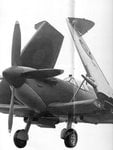Colin1
Senior Master Sergeant
ChrisI'm no expert but I believe that was for carrier Spitfires (Seafires) - space concerns.
clipped wings were configured for low-altitude performance, there would be an increase in roll rate at the expense of lift. These would typically be annotated as low-altitude birds eg LF Mk Vb, LF Mk IXe.
Lift is what you need when you're carrier-borne so there was no question of clipping the wings, the earliest sea-going Spitfires (not Seafires) had their wing tips removed and stowed in the cockpit, the only example I can think of right now being the Eagle and Wasp carriers ferrying Spitfires to within flying-in range of Malta. The Seafire eventually had folding wings to deal with the space issue.
Below: Sitting on Wasp's flight deck immediately after being hoisted on board, this Spitfire V still has the sling in position on the forward fuselage and its wing tips in the cockpit. USN
Bottom: A Seafire III showing the method of wing folding introduced with this version. Price
Attachments
Last edited:


